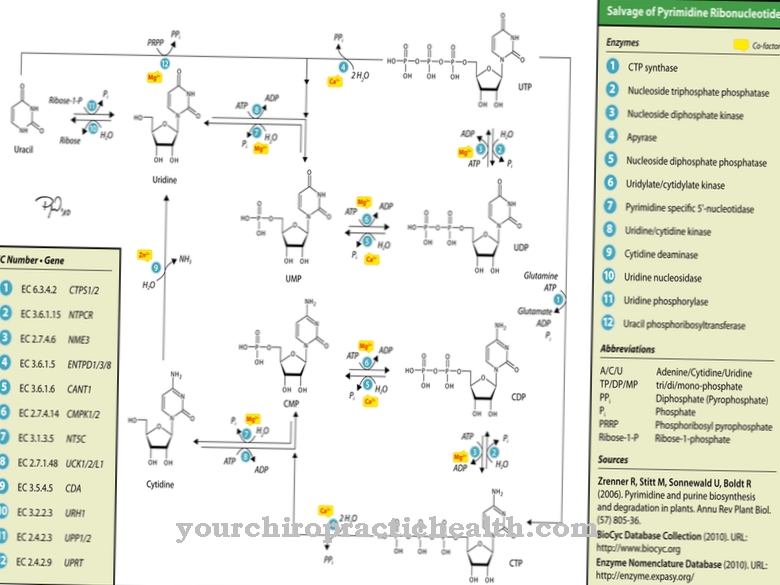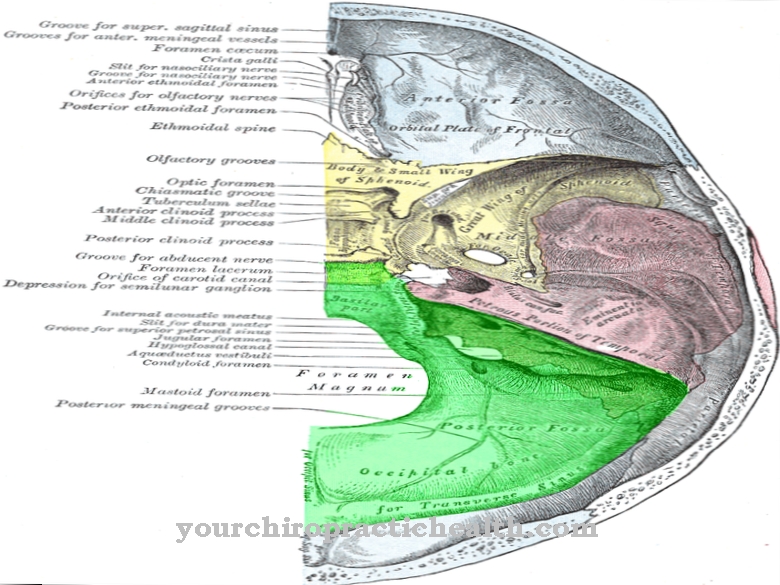As Myelin a special, particularly lipid-rich, biomembrane is the name given to it, which, as the so-called myelin or myelin sheath, encloses axons of the nerve cells of the peripheral nervous system and the central nervous system and electrically isolates the nerve fibers contained.
Because of the regular interruptions of the myelin sheaths (Ranvier cord rings), the electrical stimulus conduction occurs abruptly from cord to cord, which leads to a higher conduction speed than with continuous stimulus conduction.
What is myelin?
Myelin is a special biomembrane that envelops the axons of the peripheral nervous system (PNS) and the central nervous system (CNS) and electrically isolates them from other nerves. The myelin in the PNS is formed by Schwann cells, whereby the myelin membrane of a Schwann cell only ever "wraps" a section of one and the same axon in several to many layers.
In the CNS, the myelin membranes are formed by highly branched oligodendrocytes. Due to their special anatomy with many branched arms, oligodendrocytes can make their myelin membrane available to up to 50 axons at the same time. The myelin sheaths of the axons are interrupted every 0.2 to 1.5 mm by Ranvier cord rings, which leads to a sudden (saltatory) transmission of electrical stimuli that is faster than the continuous transmission.
The myelin protects the nerve fibers running inside against electrical signals from other nerves and requires the lowest possible loss of transmission, even over relatively long distances. Axons of the PNS can reach a length of over 1 meter.
Anatomy & structure
The high proportion of lipids in myelin has a complex structure and consists mainly of cholesterols, cerebrosides, phospholipids such as lecithin and other lipids. The proteins it contains, such as myelin basic protein (MBP) and the myelin-associated glycoprotein and some other proteins, have a decisive influence on the structure and strength of the myelin.
The composition and structure of myelin is different in the CNS and PNS. The myelin oligodendrocyte glycoprotein (MOG) plays an important role in the myelination of the axons of the CNS. The special protein is not found in the Schwann cells, which form the myelin membrane of the axons of the PNS. The peripheral myelin protein-22 is probably responsible for the firmer structure of the myelin of the Schwann cells compared to the structure of the myelin of the oligodendrocytes.
In addition to the regular interruptions in the myelin sheaths caused by the Ranvier tying rings, there are so-called Schmidt-Lantermann notches, also called myelin incisions, in the myelin sheaths. These are cytoplasmic remnants of Schwann cells or oligodendrocytes, which run as narrow strips through all myelin layers in order to ensure the necessary exchange of substances between the cells.
They take over the function of gap junctions, which allow and enable the exchange of substances between the cytoplasm of two neighboring cells.
Function & tasks
One of the most important functions of the myelin or the myelin membrane is the electrical insulation of the axons and the nerve fibers running within the axon and the rapid transmission of electrical signals. On the one hand, the electrical insulation protects against signals from other non-myelinated nerves, and it causes the nerve stimuli to be transmitted as quickly and with as little loss as possible.
Transmission speed and "line losses" are particularly important for axons in the PNS due to their length, sometimes over a meter. The electrical insulation of the axons and also of individual nerve fibers enabled a kind of miniaturization of the nervous system in the course of evolution. It was only with the invention of myelination through evolution that powerful brains with a huge number of neurons and an even greater number of synaptic connections were possible. About 50% of the brain's mass consists of white matter, i.e. myelinated axons.
Without myelination, even remotely similar complex brain performance would be completely impossible in such a small space. The optic nerve emerging from the retina, which contains around 2 million myelinated nerve fibers, is used to illustrate the proportions. Without the protection of the myelin, the optic nerve would have to be more than one meter in diameter with the same performance. Simultaneously with the myelination, the saltatory stimulus conduction emerged in evolution, which has a clear speed advantage over the continuous excitation conduction.
In simplified terms, one can imagine that ion channels are opened and closed via depolarization in order to pass the action potential on to the next section (internode). Here the action potential is built up again with the same strength, passed on and, at the end of the section, the ion pump is activated again via the depolarization and the potential is transferred to the next section.
Diseases
One of the most well-known diseases that is directly related to a gradual breakdown of the myelin membrane of axons is multiple sclerosis (MS). In the course of the disease, the myelin in the axons is broken down by the own immune system, so that MS can be classified in the category of neurodegenerative autoimmune diseases.
In contrast to Guillain-Barré syndrome, in the course of which the immune system attacks the nerve cells directly despite protection from the myelin membrane, but whose neuronal damage is partially regenerated by the body, the myelin that has degenerated from MS cannot be replaced. The exact causes for the occurrence of MS have not (yet) been adequately researched, however MS occurs more often in families, so that at least a certain genetic disposition can be assumed.
Diseases that cause the breakdown of myelin in the CNS and are based on hereditary genetic defects are known as leukodystrophies or adrenoleukodystrophy if the genetic defect is located on a locus on the X chromosome.
A vitamin B12 deficiency disease, pernicious anemia, also called Biermer's disease, also leads to a breakdown of the myelin sheaths and triggers corresponding symptoms. The specialist literature discusses the extent to which the development of mental illnesses such as schizophrenia can be causally related to functional disorders of the myelin membrane.


























